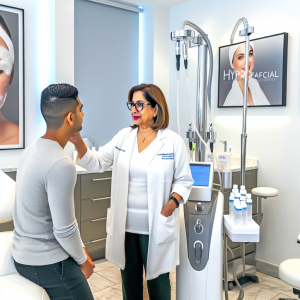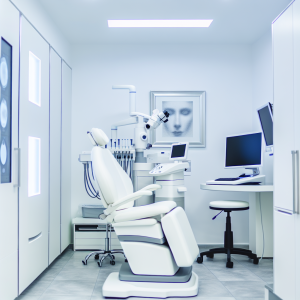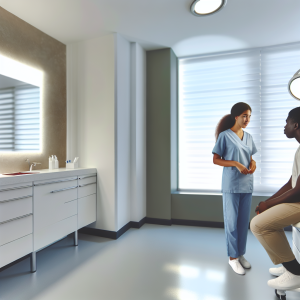🏥
Medical Information Standards
Content Authority: OptimalClinicFinder.com is a comprehensive medical directory platform connecting patients with qualified Botox providers. Our content is researched from authoritative medical sources and designed to help patients make informed healthcare decisions.
How Botox Brow Lift Works: Clinical Mechanism and Facial Anatomy
Botox works by temporarily blocking nerve signals to specific facial muscles that contribute to brow depression and forehead wrinkles. The treatment targets the procerus, corrugator supercilii, and lateral portions of the frontalis muscle, which naturally pull the brows downward with repeated contraction over time. When these depressor muscles are relaxed through botulinum toxin injection, the unopposed action of the frontalis muscle’s central fibers creates a natural lifting effect.
The mechanism involves binding to presynaptic nerve terminals and preventing the release of acetylcholine, effectively creating temporary muscle relaxation. This neuromuscular blockade typically develops over 24-72 hours and reaches peak effect by 7-14 days post-treatment. The strategic placement of injections requires detailed understanding of facial anatomy to achieve symmetrical brow elevation while maintaining natural expression and avoiding complications like eyelid ptosis.
💡
Did You Know?
Clinical studies show that Botox patients achieve excellent results when combined with professional-grade aftercare products.
Clinical Research and Evidence Base for Botox Brow Lift
The clinical development of Botox for brow lifting has been supported by numerous peer-reviewed studies demonstrating both safety and efficacy. The landmark studies by Carruthers and Carruthers established the foundational protocols for cosmetic botulinum toxin use, while subsequent research has refined injection techniques and dosing parameters. Clinical trials consistently show 85-95% patient satisfaction rates with brow lift results.
Photogrammetric analysis studies have documented measurable brow elevation of 2-4mm following treatment, with the greatest lift typically occurring in the lateral brow region. Long-term safety data spanning over two decades shows no evidence of permanent muscle weakness or systemic complications when administered by qualified practitioners. Meta-analyses of clinical outcomes demonstrate that results are reproducible across diverse patient populations and geographic regions.
Treatment Protocols and Clinical Management
Successful Botox brow lift treatment begins with comprehensive facial analysis to assess brow position, muscle strength, skin quality, and patient expectations. The evaluation process includes measuring resting brow height, evaluating muscle mass and activity patterns, and discussing realistic outcomes based on individual anatomy. Healthcare providers must assess factors like skin thickness, previous treatments, and lifestyle factors that may influence results.
The standard treatment protocol involves injecting 2-4 units of botulinum toxin at specific anatomical landmarks, typically including the medial corrugator region, procerus muscle, and lateral orbital rim. Total dose ranges from 15-25 units depending on muscle mass, gender, and desired outcome. Treatment intervals of 3-4 months maintain optimal results while minimizing the risk of antibody formation. Patient education covers post-treatment care, expected timeline for results, and signs of complications requiring medical attention.
💡
Quick Tip
Botox works best when combined with healthy lifestyle choices for optimal results.
Botox Brow Lift Results: Timeline and Expectations
Understanding the timeline for Botox brow lift results helps patients set appropriate expectations and plan for optimal outcomes. Initial effects typically become noticeable within 3-5 days as the targeted muscles begin to relax. The full lifting effect develops gradually over 7-14 days as muscle relaxation reaches its peak and the opposing lift muscles create brow elevation.
Peak results occur between 2-4 weeks post-treatment and typically last 3-4 months, though individual variation exists based on metabolism, activity level, and muscle mass. First-time patients may experience slightly shorter duration as their muscles adapt to treatment. Maintenance treatments can extend results and may allow for longer intervals between sessions as muscles become conditioned to the relaxed state.
Safety Profile and Complication Management
The safety profile of Botox for brow lifting is well-established through extensive clinical use and post-marketing surveillance. Common side effects include temporary injection site tenderness, mild bruising, and occasional headache occurring in 5-10% of patients. These effects typically resolve within 24-48 hours without intervention.
Rare but serious complications include eyelid ptosis (0.5-2% incidence), brow asymmetry, and overcorrection leading to flattened expression. Risk factors for complications include inexperienced injectors, improper dosing, and anatomical variations. When complications occur, they are typically temporary and resolve as the Botox effect wanes. Hyaluronidase injection can partially reverse effects in cases of overcorrection, though this is rarely necessary with proper technique.
Cost Analysis and Treatment Value
The cost of Botox brow lift treatment reflects multiple factors including geographic location, provider expertise, facility overhead, and competitive market dynamics. Treatment costs typically range from $300-750 per session, with pricing generally based on the number of units required rather than flat procedure fees. Urban markets and high-end practices command premium pricing, while competitive markets may offer more accessible options.
⚠️
Safety First
Always consult a qualified medical professional before starting Botox. Results vary by individual.
✓
Why Choose Botox?
●
Clinically proven
●
FDA approved
●
Minimal downtime
●
Long-lasting
When evaluating treatment value, patients should consider the temporary nature of results requiring regular maintenance every 3-4 months. Annual treatment costs range from $1,200-3,000, making Botox a significant investment compared to one-time surgical alternatives. However, the lack of downtime, lower risk profile, and reversible nature provide distinct advantages that many patients find worthwhile for achieving their aesthetic goals.
Botox Brow Lift vs. Alternative Treatments
Comparing Botox brow lift to alternative treatments helps patients select the most appropriate option for their goals, anatomy, and lifestyle. Surgical brow lifts offer more dramatic and longer-lasting results but involve significant recovery time, higher costs, and permanent changes. Thread lifts provide intermediate results with minimal downtime but may have less predictable outcomes and shorter duration than Botox.
Non-surgical alternatives include radiofrequency treatments, ultrasound therapy, and energy-based devices that tighten skin but don’t address muscle-related brow depression. Dermal fillers can create the illusion of brow lift through strategic volume placement but require different injection techniques and carry different risk profiles. The choice between treatments should consider patient anatomy, desired outcome magnitude, tolerance for downtime, and budget considerations.
Provider Selection and Treatment Quality
Selecting a qualified provider is crucial for optimal Botox brow lift outcomes and safety. Patients should seek board-certified physicians with specific training in facial anatomy and extensive experience with botulinum toxin injections. Dermatologists, plastic surgeons, and oculoplastic surgeons typically have the most relevant expertise, though some primary care physicians and nurse practitioners may also provide quality care with appropriate training.
Important selection criteria include facility accreditation, provider credentials, before-and-after photo galleries, and patient testimonials. The consultation process should include detailed facial analysis, discussion of realistic expectations, and clear communication about costs and potential risks. Patients should feel comfortable asking about provider experience, complication rates, and emergency protocols before proceeding with treatment.
📚 Medical Authorities & Professional Standards
All Botox procedures should be performed by licensed medical professionals following established clinical guidelines and safety protocols.
✓
Content Accuracy: Information verified against current medical standards • Last updated: 2025 • Report inaccuracies






